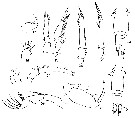|
|
 |
|
Cyclopoida ( Order ) |
|
|
|
Oncaeidae ( Family ) |
|
|
|
Oncaea ( Genus ) |
|
|
| |
Oncaea obscura Farran, 1908 (F,M) | |
| | | | | | | Ref.: | | | Farran, 1908 b (p.94, figs.F,M); Rose, 1933 a (p.301, figs.F,M); Sewell, 1948 (p.483); Björnberg & al., 1981 (p.667, figs.F,M); Malt, 1982 a (p.140, Rem.); Boxshall, 1998 (p.227); Vives & Shmeleva, 2010 (p.297, figs.F,M, Rem.) |  issued from : G.P. Farran in Fish. Ire. Sci. Invest., 1906, II [1908]. [Pl. X, Figs.14-24]. Female (from W Ireland): 14, A2; 15, Mxp; 16, Md; 18, Mx1; 19, P2; 20, P3 (endopodite); 21, P4; 23, urosome (dorsal); 24, A1. Nota : Urosome contained two-and-a-half times in length of cephalothorax. Genital segment nearly twice as long as broad ; 3rd and 4th urosomal segments short, anal segment about as broad as long. Caudal rami slightly shorter than the anal segment and twice as long as wide. Proportional length of the segments 4 :9 :16 :5 :2 :4. A2 with the upper edge 2nd segment finely serrate (as in O. ornata) ; spines of the proximal group on the 3rd segment all of about the same thickness.. Md and Mx1 resemble those of O. conifera Mxp with a moderately broad 2nd segment with 2 small marginal spines, the proximal smooth, the distal serrate ; the upper margin of the distal segment to the serrate spine is finely setose ; the inner margin of the terminal claw very finely denticulate ; basal segment is produced anteriorly into a stout thumb-like process. Endopod of P4 without terminal process (cone). Male: 17, Mxp; 22, urosome (dorsal). Nota : Genital segment narrow, a little less than twice as long as wide, the terminal lateral processes not spreading ; the three following segments very short, and the anal segment longer than usual, nearly as long as wide. Caudal rami a little shorter than in the female. The terminal spine of the endopodite only half as long as the segment. Mxp has a pear-shaped 2nd segment, with one slender marginal seta ; the upper margin of the 2nd segment is very finely setose, that of the claw being smooth.
| | | | | Compl. Ref.: | | | Furnestin, 1960 (p.238); De Decker & Mombeck, 1964 (p.13); Mazza, 1966 (p.73); Kovalev & Shmeleva, 1982 (p.86); Greze & al., 1985 (p.8); Pancucci-Papadopoulou & al., 1990 (p.199); Krsinic, 1998 (p.1051); Siokou-Frangou, 1999 (p.479); Uysal & al., 2002 (p.18, tab.1); Khelifi-Touhami & al., 2007 (p.327, Table 1); Böttger-Schnack & Schnack, 2009 (p.131, Table 5: Rem); Selifonova, 2011 a (p.77, Table 1, alien species in Black Sea); Shiganova & al., 2012 (p.61, Table 4); Uysal & Shmeleva, 2012 (p.909, Table I); Belmonte & al., 2013 (p.222, Table 2, abundance vs stations) | | | | NZ: | 5 | | |
|
Distribution map of Oncaea obscura by geographical zones
|
| | | | | | | | | | Loc: | | | South Africa (E), SW Atlant., Brazil, off W Ireland, Ibero-moroccan Bay, Medit. (Alboran Sea, Algiers, Gulf of Annaba, ? Tyrrhenian Sea, Gulf of Taranto, S Adriatic Sea, Aegean Sea, Lebanon Basin, Black Sea), SW Indian | | | | N: | 17 | | | | Lg.: | | | (24) F: 0,5; M: 0,5; {F: 0,5; M: 0,5} | | | | Rem.: | Malt (1982 a) believes that it concerns male juvenile forms (stage 5).
After Shiganova & al. (2012, p.99) this species new in the Black Sea (as other species) arise from a rise of the water surface layer temperature and/or increasing of shipping activity during the last decades. | | | Last update : 07/12/2020 | |
| | | | See my taxonomic remark on this species in the WoRMS database. | |
|
|
|
 Any use of this site for a publication will be mentioned with the following reference : Any use of this site for a publication will be mentioned with the following reference :
Razouls C., Desreumaux N., Kouwenberg J. and de Bovée F., 2005-2025. - Biodiversity of Marine Planktonic Copepods (morphology, geographical distribution and biological data). Sorbonne University, CNRS. Available at http://copepodes.obs-banyuls.fr/en [Accessed January 01, 2026] © copyright 2005-2025 Sorbonne University, CNRS
|
|
 |
 |




